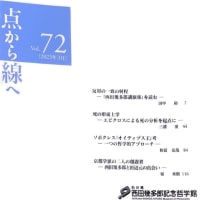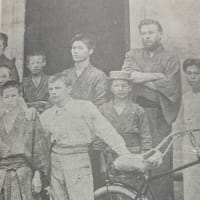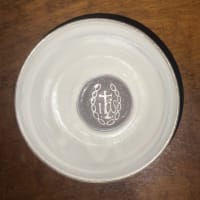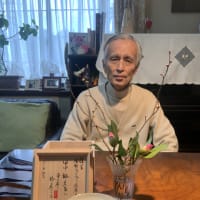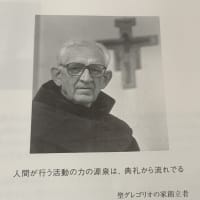One of the most controversial problems discussed in the dialogue between process theologians and the Nishida School is whether the fundamental relation of the world is "reversible" or "irreversible". Process theologians often criticize the doctrine of mutual immanence or interpenetration in Hua-Yen Buddhism on the ground that the relation of causal inheritance is non-symmetrical in the sense that the past and the future are irreversible. On the other hand , the Nishida School stresses the radically reversible relationality in the concept of sunyata, or pratityasamutpada. Both fail to grasp the significance of Whitehead's theory of the extensive continuum as a mediating link of the dialogue between them.
Yoshinori Takeuchi, an exponent of the Nishida School, criticizes "process" thinkers such as Hartshorne on the basis of Nishida's logic of topos, when he comments on Nishida's notion of the eternal Now:
Bergson and more recently an American philosopher, Professor Charles Hartshorne, think that all events of the past are restored in a metaphysical remembrance. It seems that Nishida thought through the problem above more radically: not only events of the past, but also those of the future, are all present in the eternal Now.(41)
Citing the above passage, Steve Odin criticizes Nishida on the basis of the doctrine of cumulative penetration in process theology:
In a symmetric theory of causal relatedness as posited by Nishida, relations are closed or determinate at both ends so that there is virtually no place for creativeness, novelty and freedom in such a framework. Nishida fails to address the critical problem at issue here, but instead ambiguously conjoins the notions of total interrelation and interpenetration with those of creativeness and free self-determination, despite the inherent contradictions which accompany this conjunction.(42)
Odin's criticism would be fair if Nishida really said that the future events qua concreta are present in the eternal Now. In fact, Takeuchi ' s comments are misleading in so far as Nishida never says that the future and the past have symmetrical relations in the deterministic sense. What Nishida calls "eternal Now" i s neither an object of mystical intuition nor the non-temporal abstraction of determinism, but the very condition for the possibility of spatio-temporal relations. Temporal experience is always and necessarily connected with the direct presence of something eternal which Whitehead calls the extensive continuum and which Nishida calls the "eternal Now" in his logic of Topos. The radically symmetrical or reversible relationality holds in this eternal continuum but not on the level of concrete actuality. It is not correct to regard the irreversibility of time as something like an axiom. Obviously we cannot go back in time, but the very possibility of asserting the impossibility of going back to the past shows that our past is directly present to us in the eternal continuum. If all we have is present images and if the past is not directly present to us, it would be impossible for us to tell what objects of the past these present images represent. Memory and anticipation would be impossible without the communion of the moments of time in the eternal Now, which Whitehead characterizes as the direct presence of the extensive continuum on each occasion of experience.
The point which I want to make is that the communion of the moments of time not only is compatible with the asymmetric structure of time, but also provides a necessary condition for the possibility of a linear temporal series of cumulative experience. On the other hand, the linear temporal series of cumulative experience supplements the elements of concreteness for the eternal continuum, for the concrete always has finiteness against the background of real infinite potentialities.
If Whitehead sometimes goes so far in equating creativity and God with the metaphysical receptacle of the extensive continuum as Nobo suggests, we could certainly make this trend materialize as a synthesis of process theology and the philosophy of topos in Nishida's sense. The extensive continuum presents the ground of the mutual immanence of actual occasions, i.e. finite temporal actual entities, but it cannot guarantee the communion of God and the world in so far as God is conceived as the non-temporal and omnipresent actual entity. The extensive continuum is conceived as "a complex of entities (i.e. eternal objects) united by the various allied relationships of whole to part, and of overlapping so as to possess common parts, and of contact, and of other relationships derived from these primary relationships". (43) The extensive continuum defined in this way may well be called "the topos of relative beings", which Nishida considered as the first of three degrees of the gradually deepening conceptions of topos.
In process theology, the dipolar God has been conceived either as a non-temporal actual entity or as a personal society of divine occasions. According to the logic of topos, I would like to present an alternative idea of God as the topos of relative Nothingness which is the transcendental ground of relative beings. The concept of God as the topos of the world is necessary to the Whiteheadian panentheism because "it is as true to say that the World is immanent in God, as that God is immanent in the World".(44) God is not only an actual entity but also the topos of both ideal (eternal) and actual entities . Accepting the ontological principle of seeking every reason in actualities, Whitehead postulates that the whole realm of unrealized disjunct potentialities should be in the primordial nature of God as an actual entity. The Whiteheadian God as " the unconditioned conceptual valuation of the entire multiplicity of eternal objects"(45) is the topos of eternal objects as pure potentialities : this topos must be more fundamental than the extensive continuum as the topos of real potentialities. Therefore, the dipolar God can be reinterpreted as the topos of relative Nothingness, as God is both the ground of actuality (in His primordial nature) and a chief exemplification of actuality (in His consequent nature).
In Whitehead's metaphysics, neither the extensive continuum as the topos of relative beings nor the dipolar God as the topos of relative Nothingness is the metaphysical ultimate (the universal of universals) which can include both God and the world as the "contrasted opposites". This ultimate is termed by Whitehead "creativity" (46); even "God is its primordial , non- temporal accident." In Nishida's philosophy, the metaphysical ultimate is called the topos of absolute Nothingness, in the true awareness of which there is neither God nor the Ego." (47) Whitehead need not include the extensive continuum in his categoreal scheme because creativity and God are analogous to the topos of absolute Nothingness and that of relative Nothingness in Nishida's later works. The mutual immanence of God and the World is characterized by the reciprocal dynamics of creativity in such a way that what is done in the World is transformed into a reality in heaven, and the reality in heaven passes back into the World. The solidarity of God and the world as contrasted antistrophes (48) is grounded in, the topos of absolute Nothingness, the dynamics of which Whitehead calls "creativity". The fathomless ground of God's self turns out to be the ground of ourselves in the dynamic creative process of the "inverse correlationality (逆対応)" because of "the absolutely contradictory self-identity" of the God-World relation.












